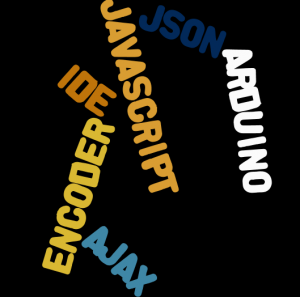As I recently migrated from the ESP8266 SDK to the Arduino IDE, I was disappointed to discover that many of the SDK features were not supported with the simplified Arduino IDE. Notably, the JSON encoding/decoding library.
I tried to add pre-built libraries from several internet repositories. But none of them would work in the Arduino environment. And all I needed was a simple encoder, built from the values captured from my sensors. So I ended up creating a simple, flat encoder myself. One with minimal sketch code. I hope this may also suite someone else’s needs as well.
Here it is. Two short sketch functions, that’s it:
#define ONEJSON 1
#define FIRSTJSON 2
#define NEXTJSON 3
#define LASTJSON 4
<span style="line-height: 1.5;">void jsonAdd(String *s, String key,String val) {</span>
*s += '"' + key + '"' + ":" + '"' + val + '"';
}
void jsonEncode(int pos, String * s, String key, String val) {
switch (pos) {
case ONEJSON:
case FIRSTJSON:
*s += "{\r\n";
jsonAdd(s,key,val);
*s+= (pos==ONEJSON) ? "\r\n}" : ",\r\n";
break;
case NEXTJSON:
jsonAdd(s,key,val);
*s+= ",\r\n";
break;
case LASTJSON:
jsonAdd(s,key,val);
*s+= "\r\n}";
break;
}
}
And now for some example calls to these functions:
//First build the response header String s = "HTTP/1.1 200 OK\r\n"; s += "Access-Control-Allow-Origin: *\r\n"; s += "Content-Type: application/json\r\n\r\n"; //Then add the JSON string to the response //Last parameter read from sensor jsonEncode(FIRSTJSON,&s,"B_Pressure", bprs); jsonEncode(NEXTJSON,&s,"DS_TempInside", tin); jsonEncode(NEXTJSON,&s,"DS_TempOutside", tout); jsonEncode(NEXTJSON,&s,"DS_TempAttic", tatt); jsonEncode(NEXTJSON,&s,"DH_Humidity", dhhumi); v = system_get_free_heap_size(); jsonEncode(NEXTJSON,&s,"SYS_Heap", v); v = millis()/1000; jsonEncode(LASTJSON,&s,"SYS_Time", v);
The resulting response message header and JSON string:
HTTP/1.1 200 OK
Access-Control-Allow-Origin: *
Content-Type: application/json
{
"B_Pressure":"29.0",
"DS_TempInside":"86.4",
"DS_TempOutside":"90.1",
"DS_TempAttic":"111.6",
"DH_Humidity":"30.0",
"DH_Temperature":"91.4",
"SYS_Heap":"32568",
"SYS_Time":"1610"
}
Notice that I added
Access-Control-Allow-Origin: *
to the response header. This is needed if you use Javascript AJAX to read the ESP8266 JSON string. Javascript will not allow cross-domain access without this in the response header. This example opens access to all domains. You can replace the * with the domain you wish to limit access to your ESP8266 from.
Hope you find this information useful.
![]()

Have you tried this?
I am planning to use it for similar scenario so would like to know if there were any pitfalls.
https://github.com/marcoschwartz/aREST/tree/master/examples/ESP8266
Thanks for bringing the aREST API to my attention.
While I have not used the aREST API you have referenced, I shall keep it in mind as a possible option. But it is very similar to the Arduino Yun bridge. I have used that without any problems. And the Spark Core (now Particle) also supports function calls and exposing variables with the value returned in JSON format. I also have experience using the Spark Core. A maximum of 10 variables could be exposed; that constraint limited it’s usefulness.
If I was going to use the aREST library, I would find out if there are limits to the number of variables or functions you can call. I would also run some tests to evaluate the reliability and stability of the API.
Hi Dave,
Thanks for the response.
I don’t see any limitations mentioned for this library.
Also I found some special mode for resource constrained devices as well.
Lightweight mode (BETA)
Btw, I used the ArduinoJson library for my current scenario just for parsing small set of json. Not sure how it works when the data becomes more complicated though.
I recently completed a porting of the AWS API to the ESP8266 using the Arduino IDE. The API includes a complete set of JSON encode/decode functions. While I prefer the EspressIF SDK for code development, I currently plan to use the AWS JSON interface when needed.
The tiny footprint JSON encoder from this post was just a stop-gap for me. It certainly is great to now be able to leverage the code endorsed by Amazon, the biggest gorilla in the room.
Here is a brief post and link to an API for AWS for ESP8266.
Great post… looking forward to see more from you on ESP-wroom-02 now 😀
Sorry! After teh sentence…. "..Two short sketch functions, that’s it:.." appears an empty rectangle!
Can you read that functions again?
Thanks!!
Thanks for your feedback. I believe the issue you noted has been corrected now. Cheers!
Thanks a ton for this post. That's saved my day!!!!!
It s 3 years old but still absolutely up-to-date.
Actually I ve spent 4 days [nights 😉 ] or more wondering why I cant get anything from the ESP8266 server (I listened with ajax-request from my Android device through WIFI, using Cordova).
And it was this missing line "Access-Control-Allow-Origin: *" that caused my app to discard everthing!!!
Adding this line to the ESP8266 server:
server.sendHeader("Access-Control-Allow-Origin","*");
Ahead of the old one:
server.send(200, "text/plain", JSONmessageBuffer);
Has done the trick ;]
THANKS AGAIN.